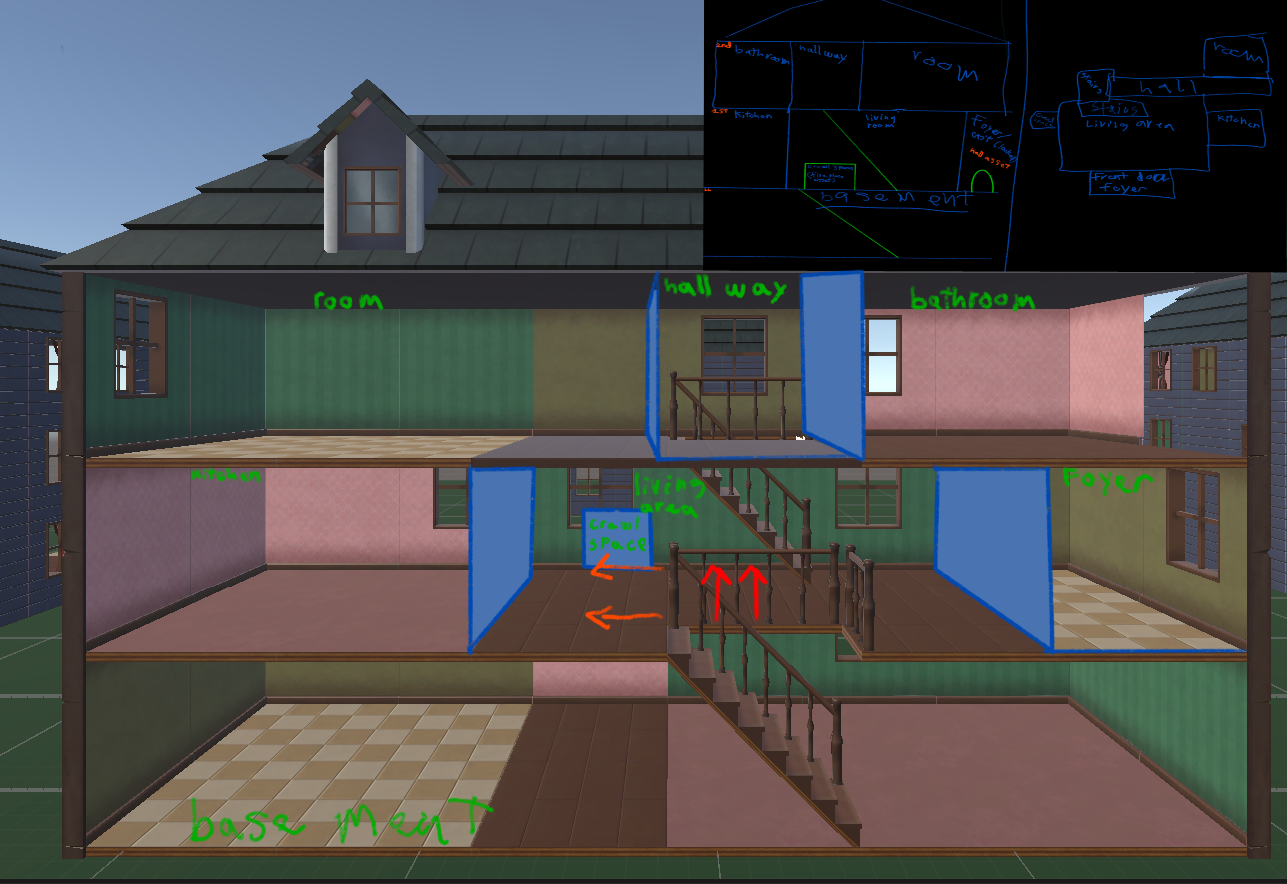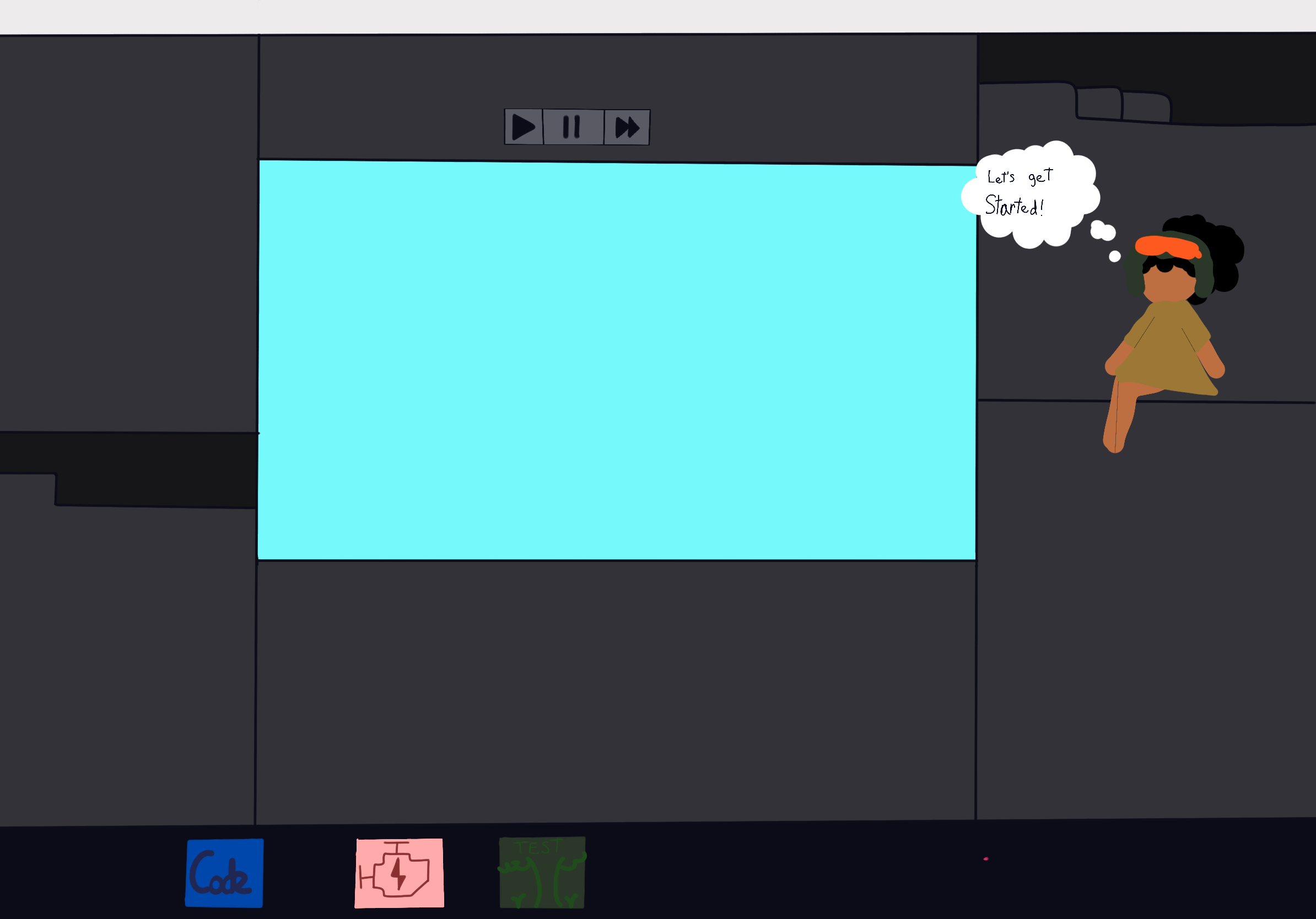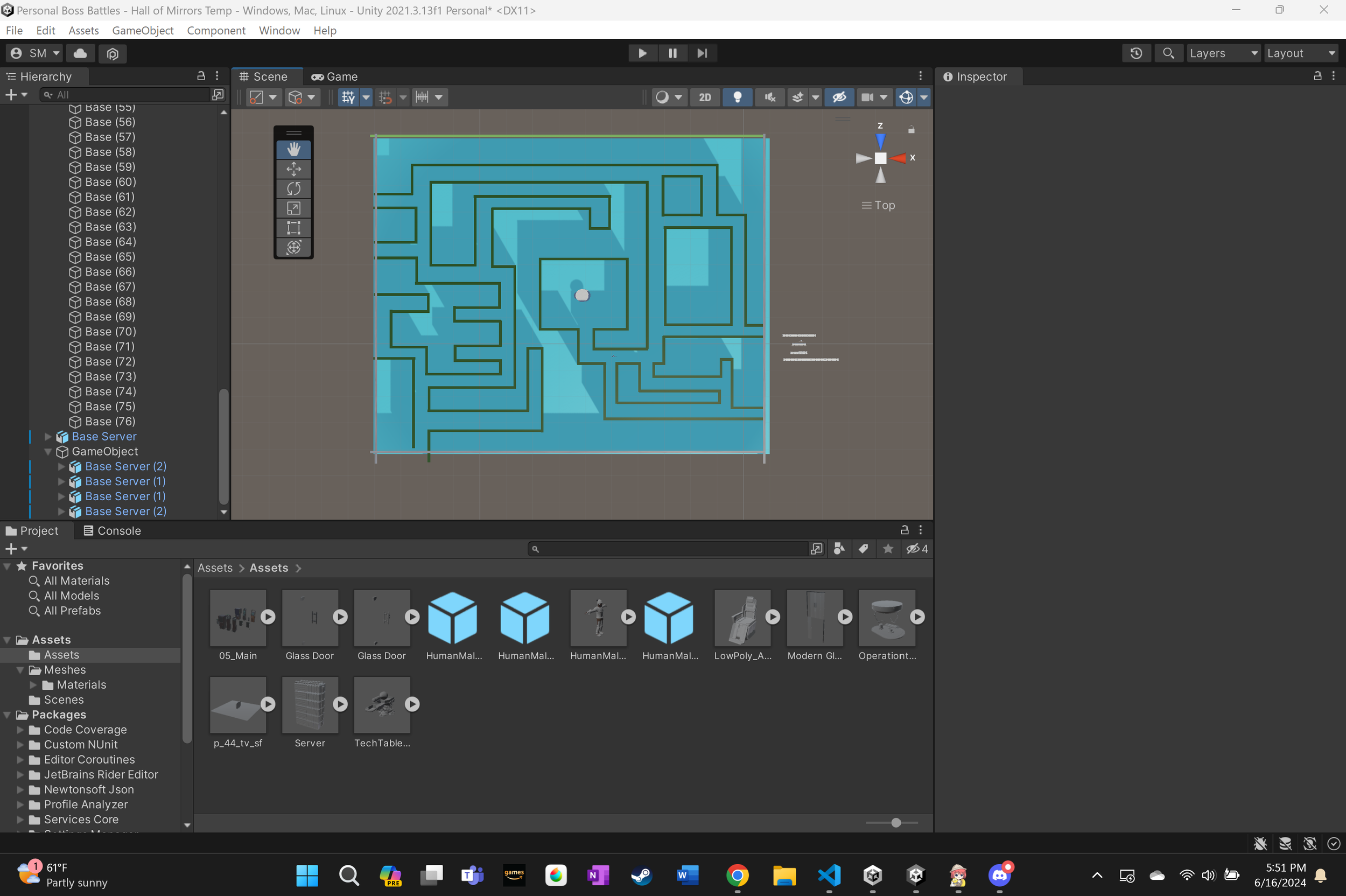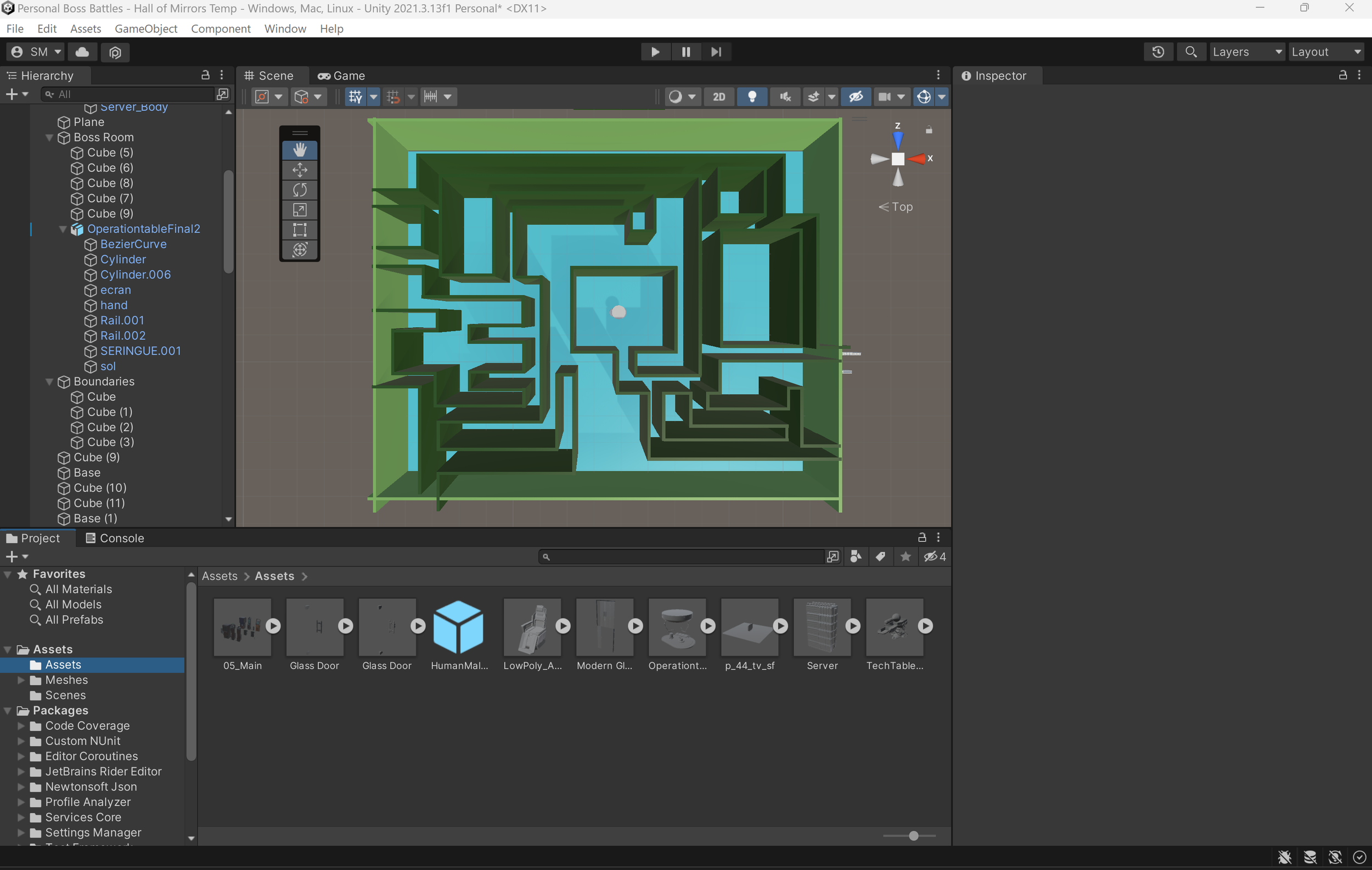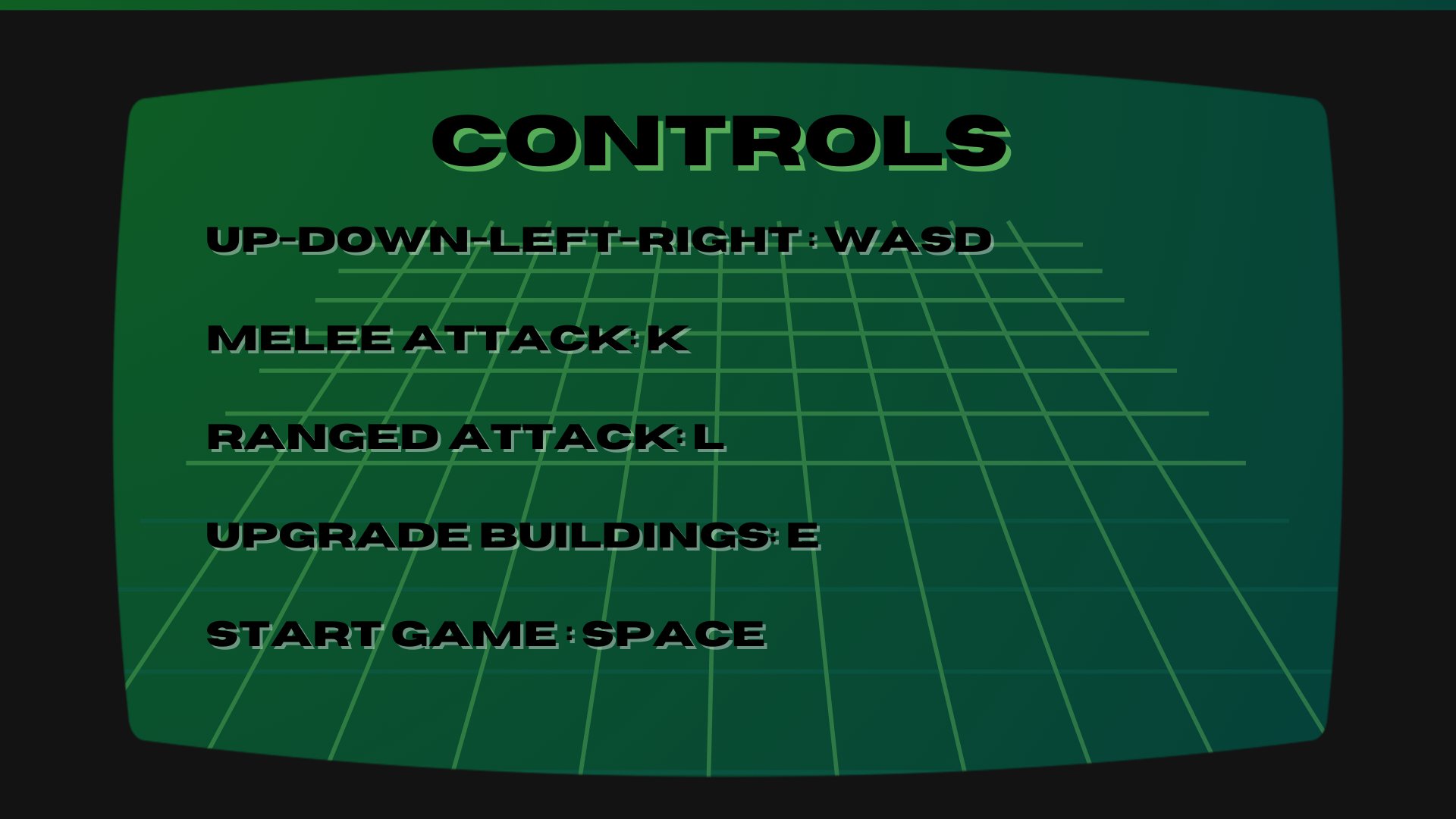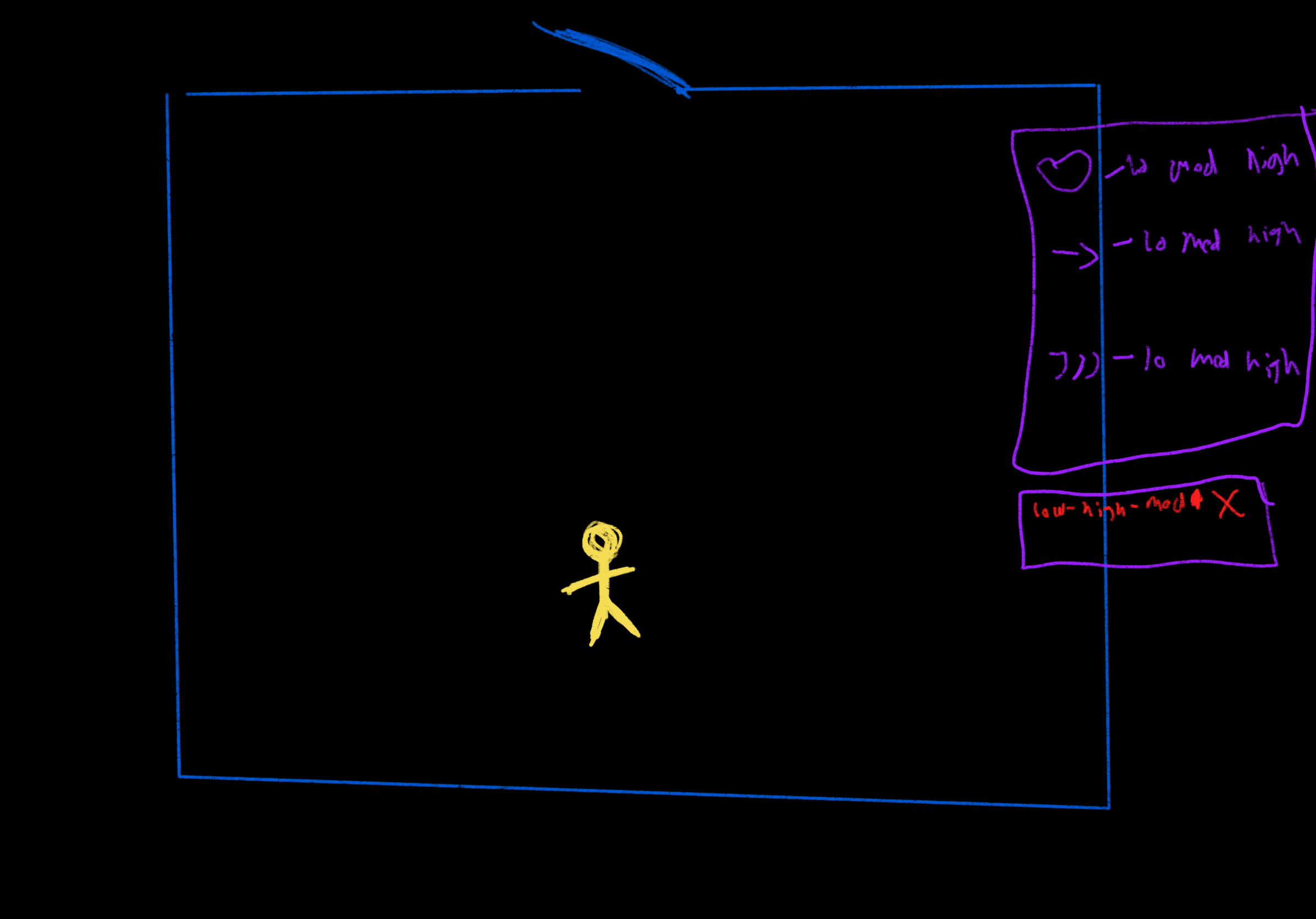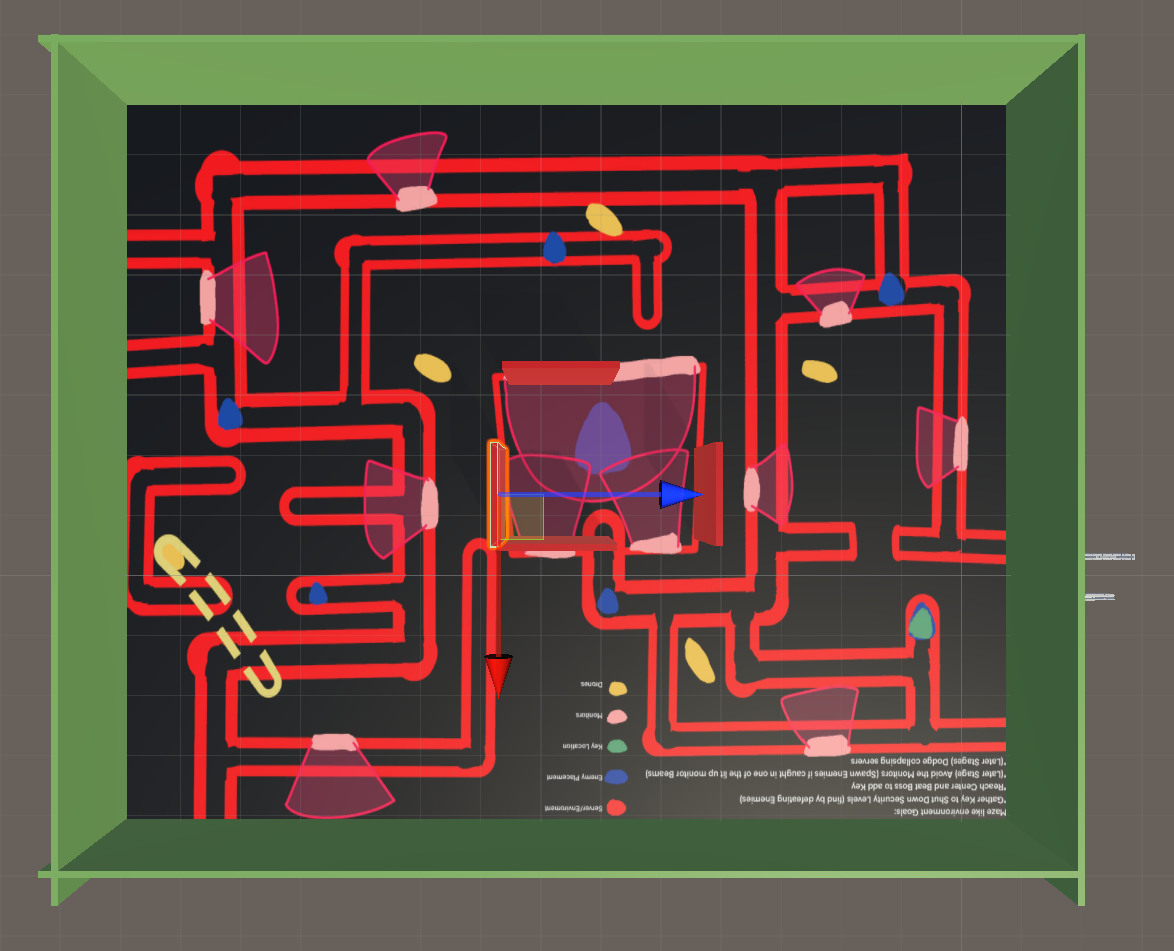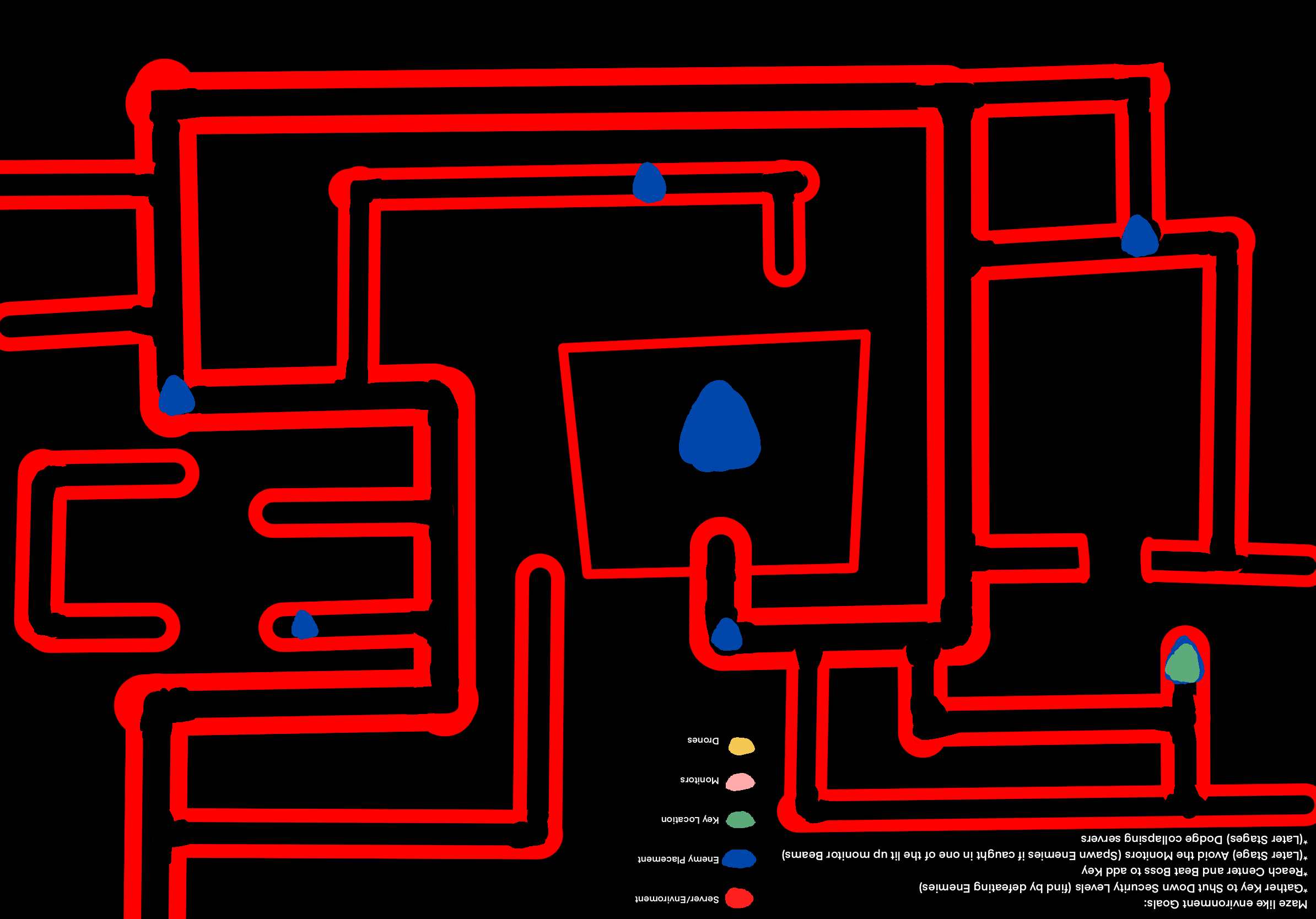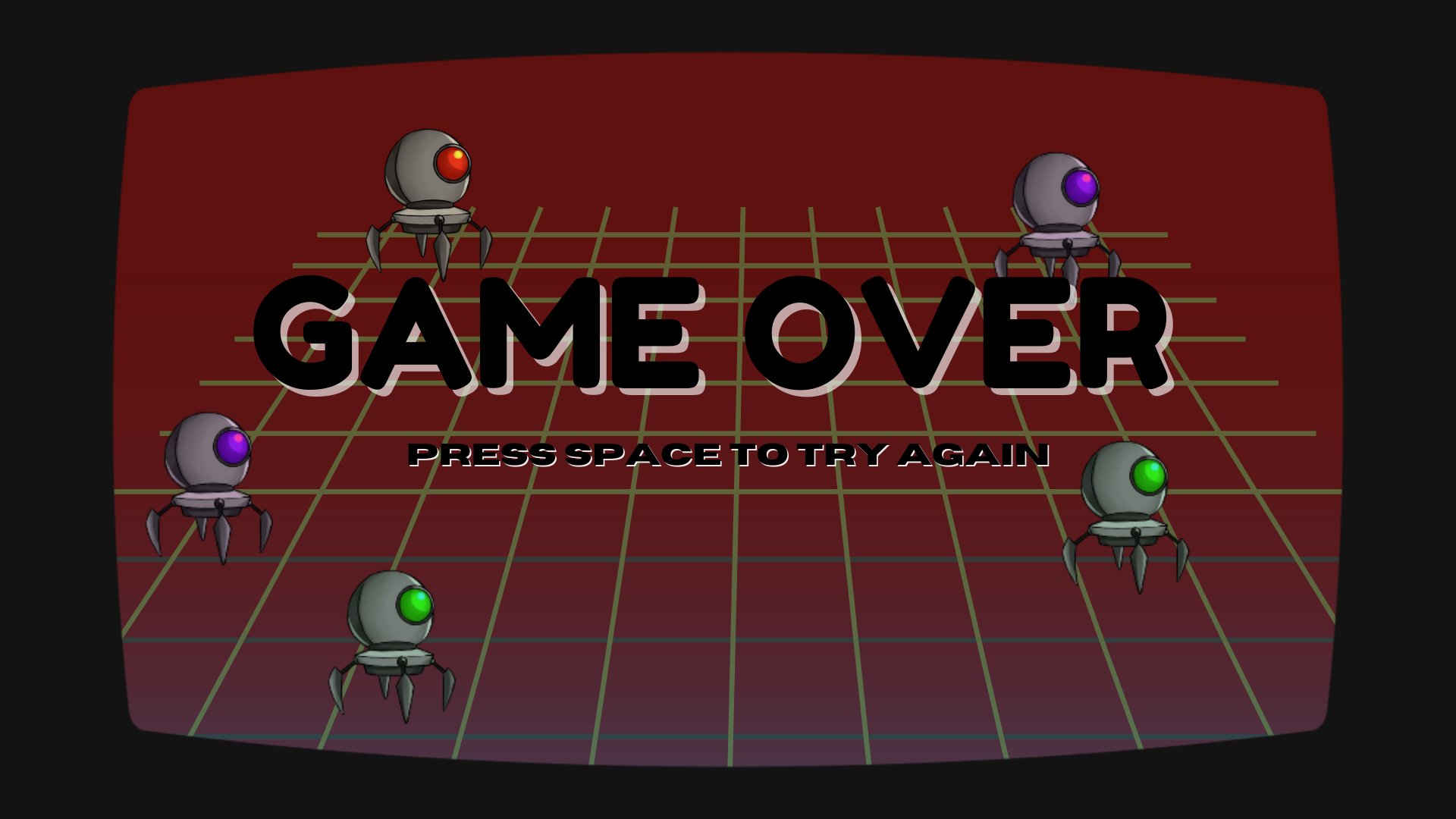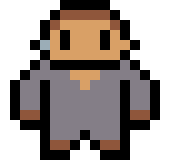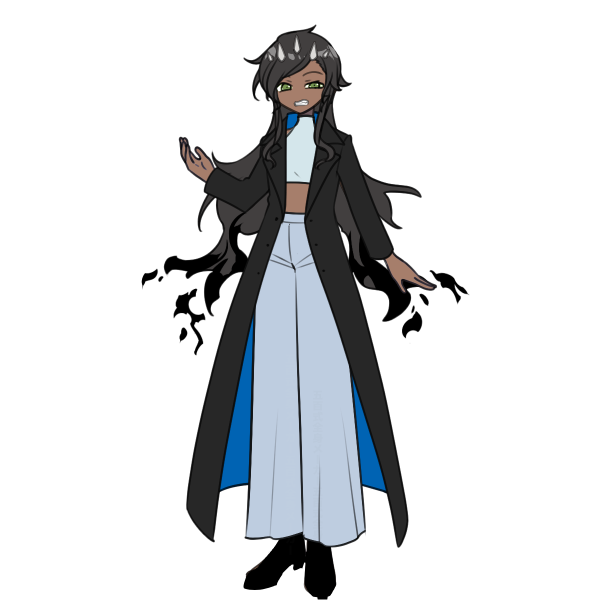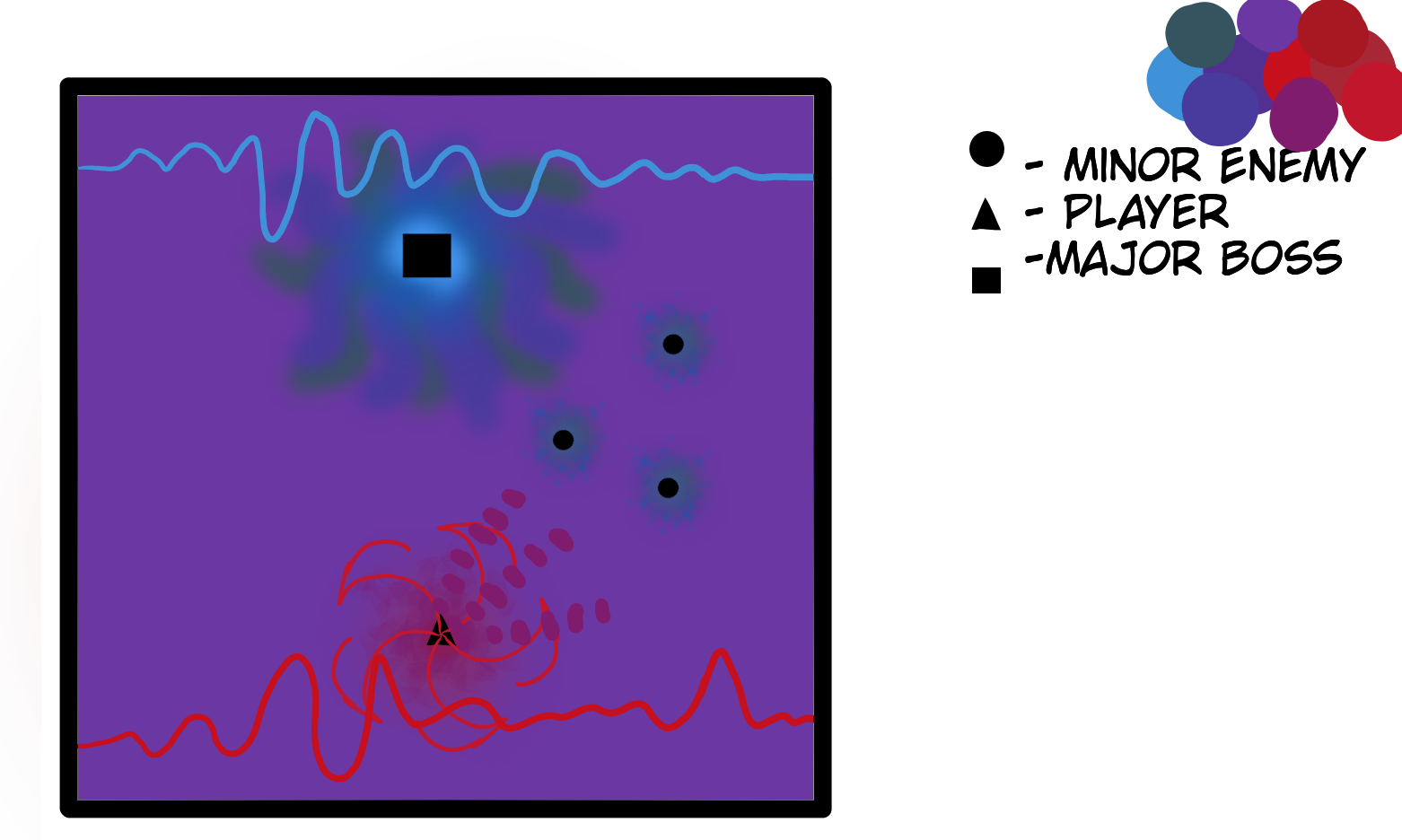Game Development
In Development
Power Suit
Power Suit is an experiment that involves creating a Demo Boss Stage for a larger game project. Players navigate a high-tech server room, overcoming a series of traps and minions while unlocking the main room to face the ultimate challenge. Along the way, they must dodge freezing TVs, drones, and other hazards while strategizing to defeat enemies and reach their goal.
Progress Report
Power Suit currently has completed enemy movement, player controls and core enviromental design as well as puzzles mechanics. Our goal is to finalize the boss area mechanics as well as the UI before pushing our first demo launch.
Utilized Unity, C++, Plastic.SCM, Prefab, Sketchfab, and Unity Assets
Demo Coming Soon Read One PagerDeveloped the backstory for the boss battle, incorporating cyberpunk themes to give context and purpose to the mission.
Created dialogue and contextual elements that reinforce the narrative, motivating the player to advance through the stage.
Integrated character motivations and goals into the gameplay, ensuring that narrative elements helped drive the player’s actions within the level.
Designed the maze-like server room environment, ensuring it was challenging yet rewarding for the player to navigate.
Developed key gameplay elements, including generating environmental obstacles and maze navigation challenges that promote player decision-making and problem-solving.
Optimized environmental features for interaction, including combat areas, trap placements, and visual cues that guide the player’s progression through the level.
Created a full breakdown of the level's duration and pacing, detailing how the stage grows over time and the different stages, movement patterns, and goals for each enemy type.
Implemented core game mechanics, such as player damage, movement, combat systems, and level switching, to ensure smooth and responsive gameplay.
Programmed the behavior of enemies, including movement, spotting and tracking the player, drone targeting, and clone attacks, to create dynamic combat encounters.
Created and designed overlays and visual feedback, such as door triggers, combat indicators, and boss damage counters, to improve player awareness and immersion in the environment.
Household Rules
Household Rules is a third-person RPG Puzzle Game inspired by Little Nightmares, What Happened to Edith Finch, and Fran Bow. The game emphasizes learning through trial and error rather than tutorials, providing players with an eerie atmosphere and innovative rule-breaking mechanics. The story and puzzles are interwoven to enhance the sense of mystery, requiring players to explore their environment and interact with the world in unexpected ways.
Progress Report
The current mockup includes the reset feature which will trigger with specific conditions to reset the player to the beginning of the day. It also includes moveup, an upfront camera angle meant to mimic the style of playing doll in an open faced dollhouse and the basic enviromental set up for demo puzzles. You can watch our demostration of current updates below!
Utilized Unity, C++, Plastic.SCM, Prefab, Sketchfab, and Unity Assets
GamePlay Soon to Come View One PagerIntegrated external assets (e.g., modular dollhouse) to create the game's environment, ensuring a unique, customizable world.
Designed key locations such as the room, hall, and kitchen, ensuring these spaces supported both gameplay flow and puzzle interactions to guide players through the world.
Ensured smooth room transitions and aligned the map layout with both the narrative and puzzle structure, enabling a seamless experience for players to follow.
Implemented four key object-based puzzles that unlocked new areas, integrating logic and environmental challenges to push the narrative forward.
Placed NPCs (e.g., Aunt, Cousin, Monster) throughout the game and programmed their movement and behavior. Ensured that breaking the rules resulted in consequences, creating tension and driving the story.
Expanded the narrative using pre-existing content to deepen the game world and immerse players in its eerie, unsettling atmosphere.
Developed lore for the NPCs, main character, and other key figures to enrich the game’s story and build out a world with depth and mystery.
Created and tied the “Household Rules” directly into both gameplay and narrative, allowing players’ interactions with the environment to trigger different consequences depending on their choices.
Developed and adjusted puzzles to align with the narrative, ensuring each puzzle felt integral to the progression and character development.
Designed a system for breaking the rules, where players could trigger resets and set up challenges for future attempts.
Developed physics-based movement and object interaction mechanics, ensuring that all actions were reactive to the player’s choices and encouraging experimentation.
Managed item use and swapping mechanics tied to the rules system, where specific objects became essential in breaking the rules or achieving goals.
Programmed AI for enemies that reacted to rule-breaking, triggering chase sequences or game resets that kept players engaged and added an element of tension.
Integrated gameplay mechanics with the puzzles to ensure that interactions were smooth and immersive, leading to satisfying and intuitive player experiences.
Projects With Demos
The Eminence
The Eminence is a rogue-like combat game created as part of a 2024 Microsoft Internship project during the Microsoft Intern Game Jam with the theme “Only One.” Eminence is a roguelike game where players engage in waves of combat, and are presented with two randomly generated clones, each with differing stats, allowing them to replace their character with a new one.
Utilized Godot, Audacity, Pixilart, Itch.IO and GDScript
Play Here View One PagerDeveloped wave-based progression and difficulty scaling, ensuring a smooth curve that kept players engaged through multiple combat waves, with increasing challenges.
Conceptualized and implemented the build replacement system, allowing players to switch characters and select new builds after each wave. This mechanic added a layer of strategy, allowing players to experiment with different playstyles.
Designed a 2D top-down camera system to complement the gameplay, providing players with optimal visibility and a smooth, immersive experience. Integrated UI elements for the start screen, end screen, and build selection to enhance the game's overall flow.
Programmed core player mechanics in GODOT, including player movement, health, damage, and death systems, to ensure smooth combat flow and player interaction.
Coded the randomization of the build generation and removal logic, maintaining a balanced and evolving gameplay experience. This ensured that players could enjoy different strategies with each wave.
Developed enemy AI systems, including movement, health, and damage logic, contributing to the dynamic and challenging wave-based combat experience. Enemies adapted to player actions, creating a constantly engaging environment.
Led a cross-functional team, coordinating tasks across various areas, including engine setup, UX design, sound integration, and player/enemy coding to create a cohesive and functional game.
Managed project milestones, ensuring that key features such as enemy AI, wave generation, and random build selection were delivered on time, keeping the team focused on core objectives.
Facilitated team meetings to track progress, prioritize critical tasks, and maintain alignment with the game’s vision and technical requirements, ensuring that every aspect of the project moved forward efficiently.
Santa’s Workshop Challenge: Precision Toy Assembly
Santa’s Workshop Challenge: Precision Toy Assembly was created during the two-week-long ABK Veteran Holiday Game Jam. The game is a toy assembly simulator where players take on the role of elves, managing tasks such as wrapping, inspecting, and assembling toys in a festive workshop. As players progress through levels of increasing difficulty, they face dynamic challenges such as item shortages, pile-ups, and defective toys, all while trying to meet holiday deadlines.
Utilized: Unity, C++, Photoshop, Blender, Trello, Itch.IO, and Customized Sound Effects
Play Here View One PagerDesigned multi-level gameplay with escalating complexity, incorporating roles such as Wrapper, Inspector, and Assembler within the toy assembly environment.
Developed and implemented error and defect mechanics, including item shortages, pile-ups, and broken toys, to introduce new challenges at each level.
Created interactive UI elements (timer, candy cane bar, Rudolph nose alarm) to communicate time constraints, progress, and errors, keeping players informed of their status and the game’s pace.
Focused on task complexity and pacing to ensure the gameplay became progressively more difficult while maintaining player engagement.
Programmed core player controls and interactions, including elf movement, object pickups, and task performance (assembly, inspection, wrapping) using Unity and custom input systems.
Developed a conveyor belt system that dynamically spawns toy parts and tasks, incorporating random errors and defects to keep gameplay fresh and challenging.
Implemented real-time mechanics for scoring, timers, and error tracking, ensuring that obstacles like pile-ups required immediate player intervention and affected progression.
Optimized performance by ensuring smooth gameplay despite multiple interactive systems running concurrently.
Led the coordination of gameplay progression, ensuring the difficulty curve and task complexity were well-balanced to keep players challenged without overwhelming them.
Ensured UI elements effectively communicated key game mechanics and supported player navigation through complex tasks.
Coordinated cross-team collaboration with international members, ensuring the cohesive development of gameplay systems, UI, and error mechanics.
Managed Agile sprints throughout the month-long development period, keeping the team on track with deliverables and ensuring timely completion of game features and bug fixes.
Carnival and Ball Toss
Created for Comp 454. A team of four created a ball toss game on the VR. Our goal was to simulate a carnival with limited movement areas and locations.
Unity, C++, Prefab Assets, Audacity Soundscape, Mixamo and Meta Quest of Oculus
Incorporated optical illusions, such as mirror effects and strategic lighting, to make smaller spaces feel expansive and immersive.
Used forced perspective to guide user focus and create dynamic, engaging views that maintain a sense of wonder.
Utilized implied complexity to create a sense of depth and intrigue with minimal resources by layering textures and lighting to simulate rich, detailed environments.
Maximized the use of color theory and ambient soundscapes to evoke the carnival atmosphere with limited assets.
Developed the ball toss mini-game in Unity, integrating VR physics for realistic throws and impacts.
Ensured compatibility with Meta VR devices, optimizing hand tracking and controller feedback for smooth, responsive gameplay.
Conducted iterative user tests to fine-tune physics settings, adjusting factors like ball weight, throw sensitivity, and collision responses.
Synced game mechanics to VR controllers, delivering haptic feedback for added immersion when interacting with the ball.
Trust Fall
Project Description
Trust Fall is an exciting 360 Rocket Racing course featuring dynamic loops, alternative paths, and a Rise-Fall Mechanic, all aimed at enhancing the thrill and challenge of the racing experience. The track is designed to engage players with fun, fast-paced driving mechanics.
Utilized UEFN, Rocket Racing Assets, Verse Programming Language
Play here with Code: 2884-4027-9824Conceptualized and created track layouts with engaging twists, loops, and alternative racing routes to offer players various course navigation paths.
Developed mockups for the track’s layout and final location, focusing on aesthetic appeal and strategic gameplay balance.
Designed surrounding architecture, including dynamic pathways, environmental features, and visual cues to enrich the course experience.
Incorporated multiple boost zones, hazards, and obstacles to add difficulty and excitement to the race, ensuring a fun but challenging experience for players of all skill levels.
Utilized internal UEFN tools to build the 3D racing course, integrating the designed layouts into a playable track environment.
Developed the Rise-Fall Mechanic, which introduces varying elevation changes throughout the track, offering unique challenges and enhancing gameplay dynamics.
Implemented physics-based mechanics, such as boost pads and environmental hazards, to ensure fluid and responsive racing experiences.
Play Tests - Into The Verse
Play Tests - Into the Verse was a project created for UNCG to host a Game Jam in partnership with Epic Games. Participants utilized Unreal Engine for Fortnite within 48 hours to build creative levels and mini-games. Our Team created an RPG Tower Climber and roguelike with branching paths, offering different challenges, resources, and environments based on player choices.
Utilized: UEFN, Verse, Procreate, and Adobe Illustrator
Play Here with Code : 6350-1259-7314 View One PagerDesigned and implemented immersive tower-climbing levels with branching pathways, creating dynamic and varied gameplay experiences.
Strategically placed enemies and obstacles to provide balanced challenges, carefully considering player progression and difficulty scaling to maintain engagement.
Developed and optimized climbing systems, including teleportation mechanics, to enhance vertical gameplay, ensuring a seamless and enjoyable player experience.
Integrated environmental features such as guide lights, audio cues, and lighting effects to improve player navigation and create a more intuitive level exploration experience.
Created puzzle elements that utilized the tower’s environment, encouraging players to engage with their surroundings and fostering a sense of discovery as they navigated through each level.
Designed and implemented a unique custom UI system, featuring a ring and hand interface, which provided clear, intuitive visual feedback to players and fit the theme of the tower-climbing adventure.
Created, designed, drew, and developed a series of unique UI features that triggered throughout the various maps, enhancing the player's immersion and connection to the environment.
Developed navigation aids such as visual cues and instructions to efficiently guide players through complex levels, ensuring they understood gameplay mechanics and objectives.
Enhanced overall user experience through iterative design, refining UI components based on player feedback to ensure functionality, clarity, and immersion.
Designed custom visual effects that integrated UI elements seamlessly with the gameplay narrative, contributing to the thematic consistency of the tower-climbing adventure.
Collaborated on narrative design to integrate story elements and environmental features that deepened the player's connection to the game world.
Fine-tuned environmental cues such as lighting, audio triggers, and level design elements, creating a cohesive and immersive experience that enhanced player engagement.
Resolved critical gameplay issues related to level transitions, teleportation systems, and enemy spawning, ensuring smooth progression and fluid gameplay flow.
Conducted iterative testing to refine core gameplay mechanics and resolve bugs, polishing the overall player experience.
Worked with Verse Programming Language to modify the camera system, successfully transforming it into a bird's-eye view for specified sections of the map. This task posed a significant challenge, requiring a deep understanding of the engine's capabilities and custom programming logic to adjust the camera behavior for specific gameplay scenarios.
Spare Parts
Spare Parts is a product of the GMTK 2024 Game Jam "Built to Scale." Our team built a fast-paced game inspired by early 2000s Cool Math Kids games, where players fight enemies to collect parts and build their city. The game combines light combat mechanics with a city-building progression system, offering a nostalgic experience.
Utilized Unity, C++, Hand Drawn Assets, Adobe Illustrator, Audacity, Trello, Plastic.SCM, and Itch.io
Play Here View One PagerCoordinated micro sprints with durations of 2, 6, and 12 hours, ensuring that tasks were broken down effectively and the team could meet specific milestones within tight deadlines.
Managed an international team spanning three time zones, handling communication, task assignments, and file management to maintain smooth collaboration and productivity.
Ensured that project deadlines were met, overseeing communication between team members about asset requirements, design goals, and feedback loops.
Created and maintained documentation for asset lists, technical requirements, and regular bug fixes, ensuring all team members had access to the necessary information and resources.
Developed environmental rule sets that impacted combat and overall gameplay, creating engaging environments that provided both challenge and player agency.
Worked closely with the artistic team to optimize the layout and asset requirements for environmental assets, ensuring that the game’s aesthetic matched the intended design and gameplay functionality.
Conceptualized the environment's layout, including building positions and locations that served narrative and gameplay purposes.
Prototyped three variations of the environmental layout, testing each to determine the best player experience, game pacing, and mechanics.
Planned and designed the in-game economy, including available resources, spending mechanics, and resource circulation, to ensure the gameplay loop was balanced and engaging.
Adjusted upgrade costs, drop rates, and probability parameters to maintain an economy aligned with playtest feedback, ensuring it was neither easy nor difficult for players to progress.
Created comprehensive documentation outlining the economic systems, including rules, resource flows, and probability rates for future iteration and adjustments.
Little Detective
Little Detective is a project developed for the Global Game Jam 2024 "Make Me Smile." It is a mystery-driven, click-n-point adventure game where players assume the role of a con artist posing as a detective to break into a wealthy manor. The objective is to investigate a crime scene, make successful deductions, and solve the mystery, all while navigating a web of deception. The project was a fun and short test of what silly things we could create.
Utilized Ren.Py, Python, Github, Photoshop, and Itch.io
Play Here View One PagerDeveloped the core narrative for Little Detective, creating an engaging storyline with mystery and humor by writing engaging dialogue and plot progression, ensuring a smooth flow that kept the player hooked while uncovering clues and solving puzzles.
Designed a web of clues, red herrings, and character motivations to challenge the player’s deduction skills and drive the investigation forward.
Worked closely with the gameplay team to ensure narrative elements were integrated smoothly with key investigation moments, allowing for natural transitions between story beats and gameplay.
Designed a user-friendly interface that reflects the detective theme, ensuring easy access to vital game functions while maintaining a clean, thematic visual style.
Created intuitive menus, including the main menu, save/load screens, and interactive buttons, ensuring a seamless experience for players navigating the game.
Developed, iterated, and fine-tuned the interfaces for the card games and click-n-point segments, ensuring clear visual cues for player actions and logical progression in investigation tasks.
Worked to balance functionality and design, ensuring players could easily track clues, make deductions, and access game features without confusion.
Lightning Round
For my Shorter Projects
WoW Quest Encounter - Xolotl
Developed a design document for a WOW Concept Quest, Overseen, Approved, and Edited by a Senior WOW Quest Designer. An endurance Encounter Quest for a World of Warcraft event centered around a trickster, Axolotl Dragon, who requires you to deplete their mana and keep them at 50% health for a win. It is designed to mimic that of Odin within older launches of WOW Events and features multiple stages of combat you’re required to trigger, as well as a skilled hand of resource management. This project is intended to showcase budding level and gameplay design skills on a higher level.
Design DocumentAdventure Architects
Adventure Architects is a free-to-play educational assistance game aimed at helping students of all ages learn core concepts of game development and engine utilization. By offering access to knowledge usually only available through self-taught courses or specific school programs.
View One PagerFormalized core gameplay mechanics, defining how players would interact with the game world and how education would be embedded within the gameplay.
Developed environment mockups to represent the visual style and layout of the game, ensuring that the aesthetic supported educational engagement.
Crafted level progression that gradually introduced game development concepts, providing players with an approachable learning curve.
Defined feature sets, focusing on providing users with tools and tasks to help them learn essential skills while maintaining a fun and engaging experience.
Animation and Lightning Sandbox Practice




